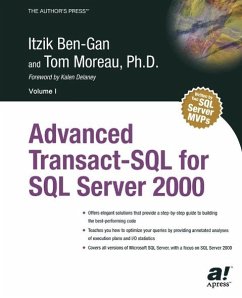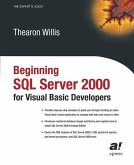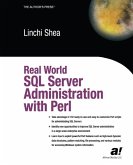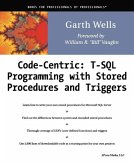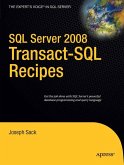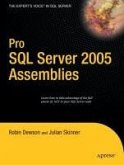47,95 €
47,95 €
inkl. MwSt.
Sofort per Download lieferbar

24 °P sammeln
47,95 €
Als Download kaufen

47,95 €
inkl. MwSt.
Sofort per Download lieferbar

24 °P sammeln
Jetzt verschenken
Alle Infos zum eBook verschenken
47,95 €
inkl. MwSt.
Sofort per Download lieferbar
Alle Infos zum eBook verschenken

24 °P sammeln
- Format: PDF
- Merkliste
- Auf die Merkliste
- Bewerten Bewerten
- Teilen
- Produkt teilen
- Produkterinnerung
- Produkterinnerung

Bitte loggen Sie sich zunächst in Ihr Kundenkonto ein oder registrieren Sie sich bei
bücher.de, um das eBook-Abo tolino select nutzen zu können.
Hier können Sie sich einloggen
Hier können Sie sich einloggen
Sie sind bereits eingeloggt. Klicken Sie auf 2. tolino select Abo, um fortzufahren.

Bitte loggen Sie sich zunächst in Ihr Kundenkonto ein oder registrieren Sie sich bei bücher.de, um das eBook-Abo tolino select nutzen zu können.
Both authors regularly write articles for the two most important magazines in the SQL Server market: SQL Server Magazine and Microsoft SQL Server Professional. The authors paid special attention to practical needs and problems raised in SQL Server programming newsgroups. Numerous examples are provided throughtout each chapter. Puzzles are presented through the book to encourage the reader to apply skills learned to difficult problems.
- Geräte: PC
- ohne Kopierschutz
- eBook Hilfe
- Größe: 52.72MB
Andere Kunden interessierten sich auch für
![Beginning SQL Server 2000 for Visual Basic Developers (eBook, PDF) Beginning SQL Server 2000 for Visual Basic Developers (eBook, PDF)]() Thearon WillisBeginning SQL Server 2000 for Visual Basic Developers (eBook, PDF)28,95 €
Thearon WillisBeginning SQL Server 2000 for Visual Basic Developers (eBook, PDF)28,95 €![Real World SQL Server Administration with Perl (eBook, PDF) Real World SQL Server Administration with Perl (eBook, PDF)]() Dave SheaReal World SQL Server Administration with Perl (eBook, PDF)43,95 €
Dave SheaReal World SQL Server Administration with Perl (eBook, PDF)43,95 €![Code Centric: T-SQL Programming with Stored Procedures and Triggers (eBook, PDF) Code Centric: T-SQL Programming with Stored Procedures and Triggers (eBook, PDF)]() Garth WellsCode Centric: T-SQL Programming with Stored Procedures and Triggers (eBook, PDF)47,95 €
Garth WellsCode Centric: T-SQL Programming with Stored Procedures and Triggers (eBook, PDF)47,95 €![SQL Server 2008 Transact-SQL Recipes (eBook, PDF) SQL Server 2008 Transact-SQL Recipes (eBook, PDF)]() Joseph SackSQL Server 2008 Transact-SQL Recipes (eBook, PDF)43,95 €
Joseph SackSQL Server 2008 Transact-SQL Recipes (eBook, PDF)43,95 €![Beginning SQL Server 2005 for Developers (eBook, PDF) Beginning SQL Server 2005 for Developers (eBook, PDF)]() Robin DewsonBeginning SQL Server 2005 for Developers (eBook, PDF)34,95 €
Robin DewsonBeginning SQL Server 2005 for Developers (eBook, PDF)34,95 €![SQL Server 2005 T-SQL Recipes (eBook, PDF) SQL Server 2005 T-SQL Recipes (eBook, PDF)]() Joseph SackSQL Server 2005 T-SQL Recipes (eBook, PDF)43,95 €
Joseph SackSQL Server 2005 T-SQL Recipes (eBook, PDF)43,95 €![Pro SQL Server 2005 Assemblies (eBook, PDF) Pro SQL Server 2005 Assemblies (eBook, PDF)]() Robin DewsonPro SQL Server 2005 Assemblies (eBook, PDF)34,95 €
Robin DewsonPro SQL Server 2005 Assemblies (eBook, PDF)34,95 €-
-
-
Both authors regularly write articles for the two most important magazines in the SQL Server market: SQL Server Magazine and Microsoft SQL Server Professional. The authors paid special attention to practical needs and problems raised in SQL Server programming newsgroups. Numerous examples are provided throughtout each chapter. Puzzles are presented through the book to encourage the reader to apply skills learned to difficult problems.
Dieser Download kann aus rechtlichen Gründen nur mit Rechnungsadresse in A, B, BG, CY, CZ, D, DK, EW, E, FIN, F, GR, HR, H, IRL, I, LT, L, LR, M, NL, PL, P, R, S, SLO, SK ausgeliefert werden.
Produktdetails
- Produktdetails
- Verlag: Apress
- Seitenzahl: 864
- Erscheinungstermin: 1. Januar 2008
- Englisch
- ISBN-13: 9781430208594
- Artikelnr.: 44062491
- Verlag: Apress
- Seitenzahl: 864
- Erscheinungstermin: 1. Januar 2008
- Englisch
- ISBN-13: 9781430208594
- Artikelnr.: 44062491
- Herstellerkennzeichnung Die Herstellerinformationen sind derzeit nicht verfügbar.
Itzik Ben-Gan is a senior SQL Server instructor and consultant with 10 years of experience in networking, development, databases, and data warehousing. He is a popular columnist and contributing editor for SQL Server Magazine. Highly certified, he is also a Microsoft Certified Trainer (MCT), a Microsoft Certified Systems Engineer + Internet (MCSE+1), a Microsoft Certified Solution Developer (MCSD), a Microsoft Certified Database Administrator (MCDBA), and a Microsoft SQL Server "Most Valuable Professional".
1 Joins in T-SQL.- 2 Subqueries and Derived Tables.- 3 Populating Tables.- 4 Other Data Manipulation Issues.- 5 Summarizing Data.- 6 Special Datatypes and Properties.- 7 Writing Code in Transact-SQL.- 8 Views.- 9 Stored Procedures.- 10 Triggers-the Hidden Stored Procedures.- 11 User-Defined Functions.- 12 Temporary Tables.- 13 Horizontally Partitioned Views.- 14 Implementing Referential Integrity and Cascading Actions.- 15 Server-Side Cursors-the SQL of Last Resort.- 16 Expanding Hierarchies.- 17 Tips and Tricks.- SQL Puzzle Solutions.- Appendix A DML Basics.- Using the SELECT Statement.- The SELECT Clause.- The INTO Clause.- The FROM Clause.- The WHERE Clause.- The GROUP BY Clause.- The HAVING Clause.- The ORDER BY Clause.- Using the INSERT Statement.- The INSERT Clause.- The Column List.- The VALUES Clause.- The Derived Table Clause.- The Execute Clause.- The DEFAULT VALUES Clause.- Using the UPDATE Statement.- The UPDATE Clause.- The SET Clause.- The FROM Clause.- The WHERE Clause.- Using the DELETE Statement.- The DELETE Clause.- The FROM Clause.- The WHERE Clause.- Appendix B Checking for ANSI Compatibility with SET FIPS_FLAGGER.- Appendix C Analyzing Query Performance.- Tools.- System Monitor (Performance Monitor).- Profiler.- SQL Enterprise Manager.- Query Analyzer.- DBCC.- System Stored Procedures.- SET Options.- Methodology.- Is It a SQL Server Problem?.- Which Query Is Slow?.- Is the Query Blocked or Deadlocked?.- What Objects Does the Query Use?.- Are All Objects Actually Being Used?.- How Does the Optimizer Access the Objects?.- How Much Data Is Being Accessed?.- Will an Index Help or Hinder?.- Are Loops and Cursors Necessary?.- Volume and Load Testing.- Appendix D Ownership Chains.- Granting Permissions.- Guidelines for Granting Permissions.- Ownershipof Objects in the Chain.- Use of Statements in Stored Procedures.- Dynamic Execution.- Object References.- Appendix E Pubs and Northwind Database Schemas.- Appendix F Dynamically Creating Triggers for Cascade Actions.- Creating a Delete Cascade Trigger on the Primary (Referenced) Table.- Creating a Prevent Delete Trigger on the Primary (Referenced) Table.- Creating an Update Cascade Trigger on the Primary (Referenced) Table.- Creating a Prevent Update Trigger on the Primary (Referenced) Table.- Creating a Prevent Insert or Update Trigger on the Secondary (Referencing) Table.- Encapsulating the Logic.- Testing the sp_CreateRelationship Stored Procedure.- Appendix G References.- Articles.- SQL Server Magazine (http://www.sglmag.com).- SQL Server Professional (http://www.pinnaclepublishing.com/SQ).- White Papers.- Books.
1 Joins in T-SQL.- 2 Subqueries and Derived Tables.- 3 Populating Tables.- 4 Other Data Manipulation Issues.- 5 Summarizing Data.- 6 Special Datatypes and Properties.- 7 Writing Code in Transact-SQL.- 8 Views.- 9 Stored Procedures.- 10 Triggers-the Hidden Stored Procedures.- 11 User-Defined Functions.- 12 Temporary Tables.- 13 Horizontally Partitioned Views.- 14 Implementing Referential Integrity and Cascading Actions.- 15 Server-Side Cursors-the SQL of Last Resort.- 16 Expanding Hierarchies.- 17 Tips and Tricks.- SQL Puzzle Solutions.- Appendix A DML Basics.- Using the SELECT Statement.- The SELECT Clause.- The INTO Clause.- The FROM Clause.- The WHERE Clause.- The GROUP BY Clause.- The HAVING Clause.- The ORDER BY Clause.- Using the INSERT Statement.- The INSERT Clause.- The Column List.- The VALUES Clause.- The Derived Table Clause.- The Execute Clause.- The DEFAULT VALUES Clause.- Using the UPDATE Statement.- The UPDATE Clause.- The SET Clause.- The FROM Clause.- The WHERE Clause.- Using the DELETE Statement.- The DELETE Clause.- The FROM Clause.- The WHERE Clause.- Appendix B Checking for ANSI Compatibility with SET FIPS_FLAGGER.- Appendix C Analyzing Query Performance.- Tools.- System Monitor (Performance Monitor).- Profiler.- SQL Enterprise Manager.- Query Analyzer.- DBCC.- System Stored Procedures.- SET Options.- Methodology.- Is It a SQL Server Problem?.- Which Query Is Slow?.- Is the Query Blocked or Deadlocked?.- What Objects Does the Query Use?.- Are All Objects Actually Being Used?.- How Does the Optimizer Access the Objects?.- How Much Data Is Being Accessed?.- Will an Index Help or Hinder?.- Are Loops and Cursors Necessary?.- Volume and Load Testing.- Appendix D Ownership Chains.- Granting Permissions.- Guidelines for Granting Permissions.- Ownershipof Objects in the Chain.- Use of Statements in Stored Procedures.- Dynamic Execution.- Object References.- Appendix E Pubs and Northwind Database Schemas.- Appendix F Dynamically Creating Triggers for Cascade Actions.- Creating a Delete Cascade Trigger on the Primary (Referenced) Table.- Creating a Prevent Delete Trigger on the Primary (Referenced) Table.- Creating an Update Cascade Trigger on the Primary (Referenced) Table.- Creating a Prevent Update Trigger on the Primary (Referenced) Table.- Creating a Prevent Insert or Update Trigger on the Secondary (Referencing) Table.- Encapsulating the Logic.- Testing the sp_CreateRelationship Stored Procedure.- Appendix G References.- Articles.- SQL Server Magazine (http://www.sglmag.com).- SQL Server Professional (http://www.pinnaclepublishing.com/SQ).- White Papers.- Books.
